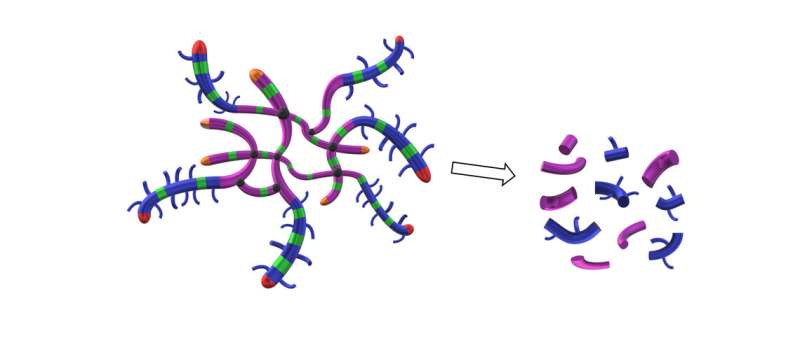A polymer that can both self-assemble into star-shaped nanoparticles and break down when no longer needed could impact chemical encapsulation technology. Credit: The Royal Society of Chemistry
A polymer with changeable properties and broad applications has been developed at A*STAR. The polymer changes between core-shell nanoparticles, self-assembled agglomerations, and degraded fragments, depending on environmental conditions. It may find applications in personal care products, agrochemicals, and nanomedicine.
Star hyperbranched polymers are formed when linear chains stretch out from a central cross-linked core. The internal cavities of these core-shell structures can be used to encapsulate smaller, hydrophobic molecules. Studies indicate that the strong chemical bonds in these materials prevent premature 'burst release' of cargo.
The robust nature of these polymers, however, also creates ecological and toxic hazards at the end of their useful life. Alexander Jackson from the A*STAR's Institute of Chemical and Engineering Sciences (ICES) and colleagues have now synthesized star hyperbranched polymers that can both encapsulate drug molecules, and then biodegrade into smaller components.
Jackson explains that chemists have developed several tools to synthesize degradable polymers, one of which involves cyclic molecules known as ketene acetals. These compounds can be opened and linked into polyesters using free radical chemistry. Unlike conventional radical polymerization, this approach introduces carbon-oxygen bonds into the polymer chain which facilitate degradation reactions.
"Radical ring-opening polymerizations of cyclic ketene acetals have been understood for about 30 years," says Jackson. "The really exciting aspect of this research was to take this chemistry and combine it with modern techniques using 'living' polymer chains."
Living polymerizations are so-called because they will continue to grow outwards upon addition of different building blocks. This gives chemists precise control over chain lengths and composition—critical features that are needed for advanced delivery devices.
Initially, the researchers used living radical polymerization to prepare methacrylate-based structures. Experiments showed that these materials could reversibly swell and contract with changes in pH and also switch between individual particles and larger nanoscale aggregates by simply changing the solution temperature. These triggers were used for controlled release of hydrophobic cargo.
Next, the A*STAR-based team optimized the conditions needed to perform ring-opening of cyclic ketene acetals simultaneously during the living methacrylate polymerization. This created a degradable analog of the initial stimuli-responsive structure.
"We will use this approach to develop even more of these kinds of polymers, including degradable polystyrene and other acrylates," says Jackson. "This will prevent undesirable accumulation of these materials after they have delivered their cargo."
Currently, the ICES scientists are helping manufacturers expand the possibilities of recyclable polymeric materials with the assistance of two industry alignment fund projects that focus on reaction engineering and encapsulation technologies.
More information: Ulrike Wais et al. Main-chain degradable star polymers comprised of pH-responsive hyperbranched cores and thermoresponsive polyethylene glycol-based coronas, Polymer Chemistry (2018). DOI: 10.1039/c8py01113c
























